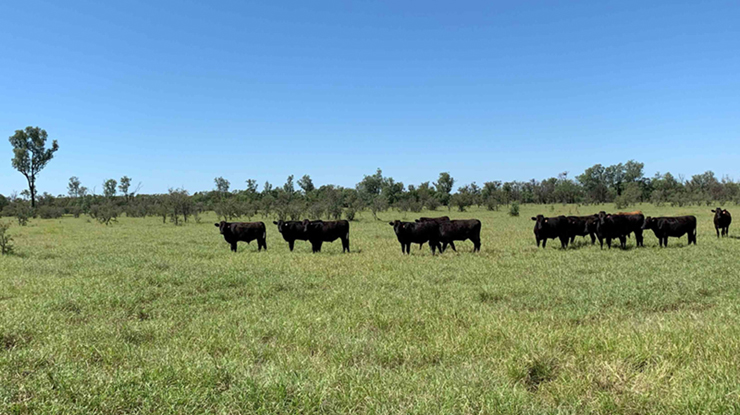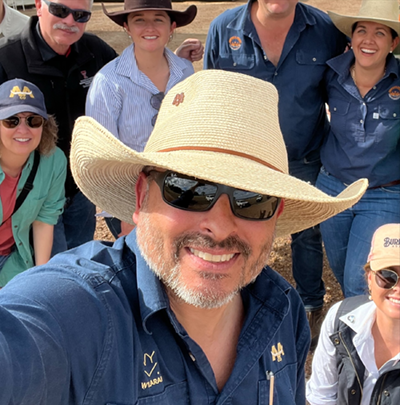
Heifers at AACo’s ‘Wylarah Station’ undergo a pestivirus vaccination program to prevent persistently infected progeny being born.
When weaners on the Australian Agricultural Company’s (AACo) Surat property, ‘Wylarah Station’, presented with respiratory symptoms in 2020, Breeding and Genetics Regional Manager Matias Suarez took a closer look.
He noticed symptoms suggestive of pestivirus infection, which was a possible cause behind the onset of bovine respiratory disease (BRD) in the weaners.
To confirm this suspicion, testing was conducted to identify stock which were persistently infected (PI) with pestivirus.
When the results indicated high incidence of PIs, the team at Wylarah took action and implemented a whole-herd Pestigard® vaccination program and a continuous weaner PI testing program.
Since then, AACo has reported a significant decrease in the annual incidences of calves testing positive for the disease, as well as a reduction in BRD in weaners.
Here, Matias joins University of Queensland Professor of Veterinary Science, Michael McGowan, to share key strategies to control and manage pestivirus.

Matias Suarez, with the aid of his colleagues at AACo, implemented a vaccine and disease testing program to prevent the spread of pestivirus.
Disease detection
When it comes to identifying if pestivirus infection is in your herd, Michael said there’s no single distinctive presentation of the disease.
“The appearance of infection in a herd can vary from lower pregnancy rates, with many cattle conceiving later than expected, to higher-than-expected losses between confirmed pregnancy to weaning,” he said.
“Probably one of the more common signs observed by producers is a large increase in number of ‘poor doing’ calves around the time of weaning.”
Signs of pestivirus infection in cattle can also include:
- Stillbirths
- calves showing signs of incoordination or malformation of their eyes
- poor suckling response
- arthrogryposis (joints fixed in abnormal positions)
- mouth and tongue ulceration
- diarrhoea
- wasting
- pneumonia in recently weaned calves or feedlot cattle
- respiratory disease symptoms.
“Because an infected herd can display a broad range of symptoms which often overlap with other diseases and issues which impact on-farm productivity, testing to confirm if pestivirus is the cause is a very important first step,” Michael said.
Reducing transmission
Matias said pestivirus is very infectious when cattle are in close contact with each other.
“If you put a persistently infected animal in a yard with susceptible animals for 24 hours, at least 60% will become infected,” he said.
So, when he received confirmation that it was pestivirus impacting the herd’s health and production, Matias immediately took steps to reduce transmission.
“AACo’s beef cattle enterprise extends across Australia and has a vertically integrated supply chain, so we take a lot of care with regards to managing and reducing the spread of infectious diseases,” he said.
“One key aspect of our production that poses significant risk for transmission is our bull breeding units as they are annually transported to herds across northern Australia for joining.
“This is why, in this instance of a confirmed pestivirus outbreak, the first thing we did was commence a program of testing to verify they were not PIs.
“We then implemented a whole-herd vaccination program, specifically with all our breeding females, to reduce risk of further PI cattle being born.
“Alongside the implementation of the vaccination program, we’ve also been testing all calves annually to ensure we are keeping on top of any risk of PIs.
“Between the first and second year of the vaccination program, we recorded a significant decrease in the number of PI calves born – demonstrating the effectiveness of the vaccine in controlling and managing dam-toprogeny transmission.”
Long-term management
When it comes to vaccination, Michael sees it as equivalent to buying insurance.
“We’ve only had the vaccine since 2004, but in these past 20 years studies have found it to be 80–85% effective in stopping the cycle of dam-to-progeny transmission,” he said.
“The vaccine operates like any other killed vaccine with an initial injection that must be followed up by a second booster, which can occur up to six months later.
“In seedstock herds, or in herds conducting artificial breeding programs, the cost-to-benefit ratio for whole-herd vaccination is positive.
“However, the cost of initiating a whole-herd vaccination program in commercial herds may be too great for many businesses.”
To combat this, Michael suggests commercial producers start with a heifer-only vaccination program.
“Heifers are the future of your herd, and they are also the group most vulnerable to experiencing an outbreak due to their lack of natural immunity,” he said.
“By protecting them from pestivirus infection, you’re insuring the future of your herd.”
Avoiding risks
Michael and Matias agree it’s important producers avoid attempting alternative measures in order to save money, as this can risk the long-term health, productivity and profitability of their herd.
“While producers may be tempted to purposely introduce a PI to their herd in hopes to encourage the development of natural herd immunity, this is a very risky approach,” Matias said.
“In theory, this may sound like a cheap and easy solution, but in practice it will likely devastate the productivity of the herd.
“At the end of the day, you simply cannot afford to not vaccinate.”








